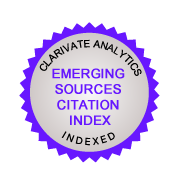COMPARATIVE EVALUATION OF CONVENTIONAL VERSUS RAPID METHODS FOR AMPLIFIABLE GENOMIC DNA ISOLATION OF CULTURED Azospirillum sp. JG3
Stalis Norma Ethica(1), Dilin Rahayu Nataningtyas(2), Puji Lestari(3), Istini Istini(4), Endang Semiarti(5), Jaka Widada(6), Tri Joko Raharjo(7*)
(1) Biotechnology Study Program of Postgraduate School, Universitas Gadjah Mada, Yogyakarta 55281
(2) Faculty of Mathematics and Natural Science, Universitas Gadjah Mada, Yogyakarta 55281
(3) Faculty of Mathematics and Natural Science, Universitas Jenderal Soedirman, Purwokerto 53123
(4) Laboratorium Penelitian dan Pengujian Terpadu, Universitas Gadjah Mada, Sekip Utara, Yogyakarta 55281
(5) Biotechnology Study Program of Postgraduate School, Universitas Gadjah Mada, Yogyakarta 55281
(6) Biotechnology Study Program of Postgraduate School, Universitas Gadjah Mada, Yogyakarta 55281
(7) Department of Chemistry, Faculty of Mathematics and Natural Sciences, Universitas Gadjah Mada, Yogyakarta 55281
(*) Corresponding Author
Abstract
Keywords
Full Text:
Full Text PDFReferences
[1] Chen, H., Rangasamy, M., Tan, S.Y., Wang, H., and Siegfried, B.D., 2010, PLos ONE, 5, 8, e11963.
[2] Kalia, A., Rattan, A., and Chopra, P., 1999, Anal. Biochem., 275, 1, 1–5.
[3] Goldenberger, D., Perschil, I., Ritzler, M., and Altwegg, M., 1995, PCR Methods Appl., 4, 6, 368–370.
[4] Wilson, K., 2001, Curr. Protoc. Mol. Biol., Ch. 2, Unit 2.4., 2.4.1–2.4.5.
[5] Moore, E., Arnscheidt, A., Krüger, A., Strömpl, C., and Mau, M., 2004, “Simplified protocols for the preparation of genomic DNA from bacterial cultures” in Molecular Microbial Ecology Manual, 2nd ed., Kluwer Academic Publisher, Netherland, 1.01, 3–18.
[6] Pedraza, R.O., Díaz-Ricci, J.C., Spencer, J.F.T., and de Spencer, A.L.R., 2004, “A simple method for obtaining DNA suitable for RAPD analysis from Azospirillum” in Environmental Microbiology: Methods and Protocols, Humana Press, Totowa, USA, 16,151–157.
[7] Dauphin, L.A., Stephens, K.W., Eufinger, S.C., and Bowen, M.D., 2009, J. Appl. Microbiol., 108, 1, 163–172.
[8] Shahriar, M., Haque, Md.R., Kabir, S., Dewan, I., and Bhuyian, M.A., 2011, J. Pharm. Sci., 4, 1, 53–57.
[9] Dickson, E.M., Riggio, M.P., and Macpherson, L., 2005, J. Med. Microbiol., 54, 3, 299–303.
[10] Vitzthum, F., Geiger, G., Bisswanger, H., Elkine, B., Brunner, H., and Bernhagen, J., 2000, Nucleic Acid Res., 28, 8, e37.
[11] Mavingui, P., Flores,M., Guo,X., Dávila, G., Perret, X.,Broughton, W.J.,and Palacios, R., 2002, J. Bacteriol., 184, 1, 171–176.
[12] Chen, W-P., and Kuo, T-T., 1993, Nucleic Acid Res., 21, 9, 2260.
[13] Schneegurt, M.A., Dore, S.Y., and Kulpa, Jr.C.F., 2003, Curr. Issues Mol. Biol., 5, 1, 1–8.
[14] Lucchini, F., Kmet, V., Cesena, C., Coppi L., Bottazzi, V., and Morelli, L., FEMS Microbiol. Lett., 158, 2, 273–278.
[15] Joshi, A.K., Baichwal, V., and Ames, G.F., 1991, BioTechniques, 10, 42–44.
[16] Fode-Vaughan, K.A., Wimpee, C.F., Remsen, C.C., and Collins, M.L.P., 2001, BioTechniques, 31, 598–607.
[17] Díaz-Zorita, M., and Fernández-Canigia, M.V., 2009, Eur. J. Soil Biol., 45, 1, 3–11.
[18] Hartmann, A., and Bashan, Y., 2009, Eur. J. Soil Biol., 45, 1–2.
[19] Lestari, P., Handayani, S.N., and Oedjijono. 2009, Molekul, 4, 2, 73–82.
[20] Zusfahair, and Ningsih, D.R., 2012, Molekul 7, 1, 9–19.
[21] Geneaid®, 2013, Genomic DNA Mini Kit: Cultured Bacteria Protocol, Geneaid Biotech, Taipei.
[22] Kim, C., Kecskés, M.L., Deaker, R.J., Gilchrist, K., New, P.B., Kennedy, I.R., Kim, S., and Sa, T., 2005, Can. J. Microbiol., 51, 11, 948–956.
[23] Espinosa, I., Báez, M., Percedo, M.I., and Martínez, S., 2013, Rev. Salud Anim., 35, 1, 59–63.
[24] Wan, M., Rosenberg, J.N., Faruq, J., Betenbaugh, M.J., and Xia, J., 2011, Biotechnol. Lett., 33, 8, 1615–1619.
[25] Sheu, D-S., Wang, Y-T., and Lee, C-Y., 2000, Microbiology, 146, 8, 2019–2025.
Article Metrics
Copyright (c) 2013 Indonesian Journal of Chemistry

This work is licensed under a Creative Commons Attribution-NonCommercial-NoDerivatives 4.0 International License.
Indonesian Journal of Chemistry (ISSN 1411-9420 /e-ISSN 2460-1578) - Chemistry Department, Universitas Gadjah Mada, Indonesia.












